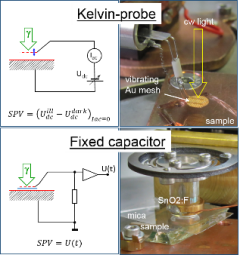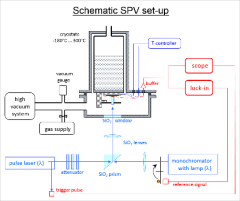SPV signals are detected with electrodes in the Kelvin-probe or fixed capacitor arrangements. Parameters of the exciting light (cw or pulsed or modulated excitation, variation of the photon energy from UV to NIR, variation of the intensity over many orders of magnitude) and of the sample (ambient from vacuum over gas atmospheres to electrolytes, temperature from about -180°C to 300°C, external bias potential, front or back illumination) can be varied. Under excitation with short laser pulses in the fixed capacitor arrangement, time dependent SPV signals can be measured from the ns to the min range and even longer. SPV measurements allow for dedicated experiments on light-induced processes in photoactive materials as well as for monitoring of indicative parameters in technology development.
Indicative parameters for SPV analysis are, for example,
- the sign of SPV signals (gives the direction of charge separation),
- onset energies of SPV signals (give information about transitions and electronic states from which charge separation is possible; such as band gaps or defect states)
- amplitudes of SPV transients (SPVmax) excited in a semiconductor at high intensity (large signal case, information about band bending - j0)
- dependence of SPVmax on a bias potential (information about the density of interface states - Dit, application for c-Si surfaces)
- dependence of the light intensity on the absorption length of a semiconductor at constant SPV (information about the diffusion or transport length)
- rise and decay times (information about generation, recombination, trapping and transport processes)



